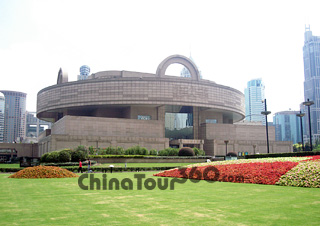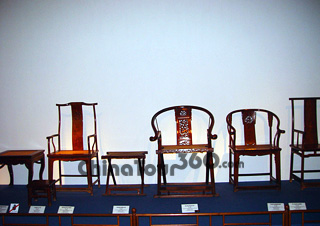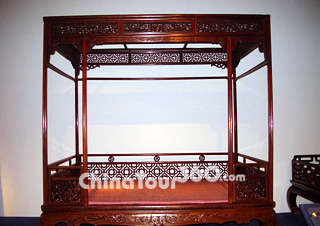Shanghai Museum is one of the must-see attractions in Shanghai. Housing over 120,000 pieces of precious cultural relics, it is an ideal place to learn about the Chinese history and culture.
The museum was first established in 1952 in the Shanghai Rice Club at No. 325, Nanjing West Road.. In 1996 it was moved to the new site at No. 201 People’s Avenue (Ren Min Da Dao). Covering an area of 39,200 square meters (1,550 square yards), the Shanghai Museum is a round building on a square base, embodying the traditional Chinese idea of “the sky is round and the ground is square”. There are 13 exhibition rooms and 3 temporary exhibition halls in the museum.
The museum boasts large collections of precious cultural relics, especially bronze wares, pottery, porcelain, and ancient painting and calligraphy works.
The bronze wares are exhibited on the first floor. Over 400 beautiful bronze wares produced between Prehistoric Times (21st century BC) and the Han Dynasty (206 BC - 220 AD) are displayed, illustrating the development of bronzes in ancient China.
Ancient sculptures are exhibited in the rooms opposite to the bronzes.
Potteries and porcelain wares exhibition halls are on the second floor. There are displays of over 500 pieces, of ancient pottery from the Neolithic Period to the tri-colored glazed pottery of the Tang Dynasty (618 - 907), and porcelain wares from the Tang Dynasty to theQing Dynasty (1644 - 1911), exemplified by the exquisite colored porcelain made in Jingdezhen.
The third floor of the museum houses large number Chinese ancient painting and calligraphy works. These include brush painting works between the Tang Dynasty and modern times, and calligraphy works from the Song Dynasty (960 - 1279) to the Qing Dynasty. There are also relies of the earliest Chinese calligraphy - inscriptions on bones or tortoise shells.
On the fourth floor, there displayed furniture of the Ming and Qing dynasties, art and crafts of the Chinese minority groups, ancient Chinese money, and ancient jade wares.
In additional to these permanent exhibitions, from time to time the museum holds all kinds of cultural lectures and temporary exhibitions.
![]() Travel Tips:
Travel Tips:
![]() Entrance Fee: free (CNY 20 for special exhibition)
Entrance Fee: free (CNY 20 for special exhibition)
The museum receives 8,000 visitors a day. Individual visitors can enter the museum directly. Reservation for group visitors can be made two weeks in advance by telephone (+86-21-63723500-132) .
![]() Opening Hours: 09:00 - 17:00 (visitors are suggested to enter before 16:00)
Opening Hours: 09:00 - 17:00 (visitors are suggested to enter before 16:00)
![]() Contact Information
Contact Information
![]() Hotline: +86-21-95958686
Hotline: +86-21-95958686
![]() Website: www.shanghaimuseum.net
Website: www.shanghaimuseum.net
![]() Email: webmaster@shanghaimuseum.net
Email: webmaster@shanghaimuseum.net
![]() Transportation:
Transportation:
A. For East Yan'an Road Pu'an Road bus stop, take Bus No. 71, 935 or 936
B. For Pu'an Road East Yan'an Road stop, take Bus No. 48, 455, 581, 782, 934 or 983;
C. For Renmin Square stop, take Bus No. 18, 46, 49, 108, 123, 123 (Through), 145, 167, 312, 451, 518, 584, 802, 916, 925, 925B, 952, 952B, 980, Shang-Chuan Special Line, Tunnel Line (Night), Tunnel Line 3 or Xin-Chuan Special Line;
D. For Renmin Square subway station, take Subway Line 1, 2 or 8.
![]() Services:
Services:
1. The Ministry of Education in China provides free tour guides for those visitors who have made group reservation to visit the museum; there is multi-language digital guide equipment which supports Chinese, English, Japanese and French.
2. The museum has easy access for those who need a wheelchair or stroller; and it also offers free wheelchairs, strollers, sewing kits and medical kits.
![]() Attention: Some salesmen from an illegal teahouse near the museum pretend to be visitors and invite foreigners to drink tea in the teahouse. They also suggest foreigners should buy some tea at very high price. So please look out for those who seem to be very “friendly”.
Attention: Some salesmen from an illegal teahouse near the museum pretend to be visitors and invite foreigners to drink tea in the teahouse. They also suggest foreigners should buy some tea at very high price. So please look out for those who seem to be very “friendly”.
Home > Destination > Shanghai > Attractions > Shanghai Museum
Nearby Attractions
Shanghai Bus Search
Shanghai Museum
Ask QuestionAsk a Question about Shanghai Museum










